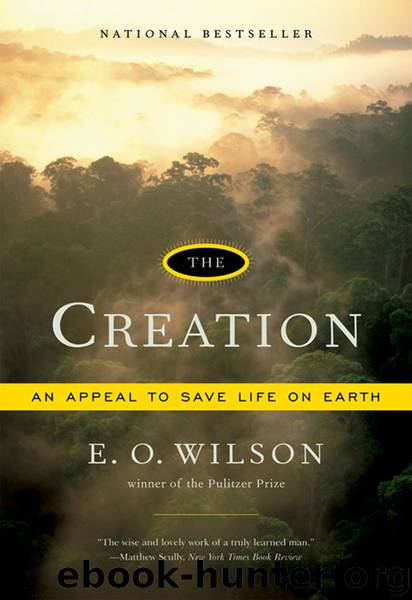The Creation by Edward O. Wilson

Author:Edward O. Wilson
Language: eng
Format: epub
Publisher: W. W. Norton & Company
Published: 2006-04-30T16:00:00+00:00
An ivory-billed woodpecker. (From James C. Greenway Jr., Extinct and Vanishing Birds [New York: American Committee for International Wildlife Protection, 1958], p. 358.)
A new and already world famous Lazarus candidate is the ivory-billed woodpecker, a dramatically large, conspicuous bird of the southern United States. The Lord God bird, as it was sometimes locally called (some people would say when they first saw one, “Lord God, what is that?”), was thought to have gone extinct in 1944, when the last known individual was spotted in the newly cut-over Singer tract of Louisiana. In the years to follow, birders searched for ivorybills in the sparse remnants of its favored habitat, the old-growth bottomland forests. Occasional rumors of sighting were heard—they were favorite items of gossip among naturalists—but none was substantiated. As hope faded, the ivorybill became the Holy Grail of ornithology, a legendary being, pursued only by the obsessed. Then, in the spring of 2005, came some electrifying news: a male had been spotted the year before in the floodplain forest of the Cache River Wildlife Refuge, of eastern Arkansas, and then quietly verified by experts by eight more sightings. Its red peaked crown and white primaries are evident in photographs and a videotape. The number surviving must be very small, given the five to fifteen square miles of old-growth forest needed to support a single pair. The Cache River reserve might support twenty to sixty pairs under optimal conditions. Yet, it is equally possible that all the sightings to date in 2005 are of only a single individual.
The successes of last-ditch efforts and the occasional rediscovery of supposedly lost species should not beguile us into thinking that in time we will see a great deal of lost biodiversity return in the diminished space we have left to Nature, such as the Cache River bottomlands. To make this point clear, it is necessary only to list the bird species native to the United States that have disappeared during the past quarter century, with the date of their last sighting. Most are island species, and two, the mallard and sparrow, may be of less than species rank: olomao (1980), Mariana mallard (1981), Guam flycatcher (1983), kamao (1985), Oahu alauahio (1985), Kauai’oo (1987), dusky seaside sparrow (1987), ou (1989), poouli (2005). Because most of these species were limited from the start to small geographical ranges, in contrast to the ivory-billed woodpecker, there is much less chance they still survive.
Successful recoveries of critically endangered species will of necessity continue to be rare exceptions. So we come back to the Lazarus dream. The sobering truth is that all the zoos in the world can sustain breeding populations of a maximum of only two thousand mammal species, out of about five thousand known to exist. A similar limitation exists for birds. Botanical gardens and arboreta are more capacious, but would be over-whelmed by the tens of thousands of plant species needing protection. The same is true of fishes that might be saved in aquaria. A lot of
Download
This site does not store any files on its server. We only index and link to content provided by other sites. Please contact the content providers to delete copyright contents if any and email us, we'll remove relevant links or contents immediately.
| Acoustics | Bridges |
| Earthwork Design | Environmental |
| Fire Science | Highway & Traffic |
| Hydrology | Remote Sensing |
| Seismic Design | Structural |
| Structural Dynamics | Surveying & Photogrammetry |
| Transportation |
Whiskies Galore by Ian Buxton(41869)
Introduction to Aircraft Design (Cambridge Aerospace Series) by John P. Fielding(33064)
Small Unmanned Fixed-wing Aircraft Design by Andrew J. Keane Andras Sobester James P. Scanlan & András Sóbester & James P. Scanlan(32743)
Craft Beer for the Homebrewer by Michael Agnew(18140)
Turbulence by E. J. Noyes(7935)
The Complete Stick Figure Physics Tutorials by Allen Sarah(7307)
Kaplan MCAT General Chemistry Review by Kaplan(6866)
The Thirst by Nesbo Jo(6826)
Bad Blood by John Carreyrou(6543)
Modelling of Convective Heat and Mass Transfer in Rotating Flows by Igor V. Shevchuk(6391)
Learning SQL by Alan Beaulieu(6208)
Weapons of Math Destruction by Cathy O'Neil(6142)
Man-made Catastrophes and Risk Information Concealment by Dmitry Chernov & Didier Sornette(5921)
Digital Minimalism by Cal Newport;(5661)
Life 3.0: Being Human in the Age of Artificial Intelligence by Tegmark Max(5474)
iGen by Jean M. Twenge(5366)
Secrets of Antigravity Propulsion: Tesla, UFOs, and Classified Aerospace Technology by Ph.D. Paul A. Laviolette(5309)
Design of Trajectory Optimization Approach for Space Maneuver Vehicle Skip Entry Problems by Runqi Chai & Al Savvaris & Antonios Tsourdos & Senchun Chai(5011)
Electronic Devices & Circuits by Jacob Millman & Christos C. Halkias(4907)
